Harris C.M., Piersol A.G. Harris Shock and vibration handbook
Подождите немного. Документ загружается.


IMPACT WITHOUT REBOUND
When impact of the isolator occurs without rebound, it must be recognized that the
equipment-isolator system continues to oscillate until the initial kinetic energy is
dissipated. Consider the system of Fig. 31.4; it consists of equipment m
1
, shock iso-
lator (left spring-dashpot unit), and flexible component (subsystem 2). The system
is initially at rest. The left end of the shock isolator is attached to a support (not
shown) which is given a velocity step of magnitude
˙
u
m
at t = 0. The subsequent
motion of the support is u =
˙
u
m
t. Determine the maximum force F
1m
transmitted by
the isolator, the maximum isolator deflection δ
1m
, and the maximum acceleration
¨
x
2m
of the component.
Solutions are available only for linear systems, i.e., linear springs and viscous
damping.Two such simplified analyses of this problem are included in the following
sections: (1) The influence of damping is considered, but the component mass m
2
is
assumed of negligible size relative to m
1
and (2) damping is neglected but the effect
of the mass m
2
of the component upon the motion of the system is considered.
Component Mass Negligible. Assume that m
1
>> m
2
so that the motion x
1
of the
equipment may be determined by neglecting the effect of the component. Then the
extreme value of the force F
1m
transmitted by the isolator and the extreme deflection
δ
1m
of the isolator occur during the first quarter-cycle of the equipment motion; they
may be found from Figs. 31.14 and 31.15 in the section on Response of a Rigid Body
System to a Velocity Step. The subsequent motion of the equipment is an exponentially
decaying sinusoidal oscillation or, if there is no damping in the isolator, a constant-
amplitude oscillation. If the component also is undamped, an analytic determination
of the component response is not difficult.The motion consists of harmonic oscillation
at the frequency ω
n1
of the equipment oscillation and a superposed oscillation at the
frequency ω
n2
of the component system. Since the oscillations are assumed to persist
indefinitely in the absence of damping, the extreme acceleration of the component is
the sum of the absolute values of the maximum accelerations associated with the oscil-
lations at frequencies ω
n1
and ω
n2
. In the particular case of resonance (ω
n1
=ω
n2
), the
vibration amplitude of the component increases indefinitely with time. Because actual
systems always possess damping (usually a considerable amount in the isolator), solu-
tions of this type tend to be unduly conservative for engineering applications.
The equation of motion for the viscous damped component is a special case of
Eq. (31.5) with F(
˙
δ,δ) as given by Eq. (31.7). If appropriate subscripts are supplied
and customary substitutions are made, the equation is
¨
δ
2
+ 2ζ
2
ω
n2
˙
δ
2
+ω
n2
2
δ
2
=−
¨
x
1
(31.38)
Analytic solutions of Eq. (31.38) to find the acceleration
¨
x
2
=
¨
x
1
+
¨
δ
2
of the compo-
nent are too laborious to be practical. However, computer-generated results are
shown in Fig. 31.28. The ordinate is the ratio of the maximum acceleration
¨
x
2m
of the
component to the maximum acceleration
˙
u
m
ω
n2
[see Eq. (31.19)] that the component
would experience if the shock isolator were rigid. The abscissa is the ratio of the
undamped natural frequency ω
n2
of the component to the undamped natural fre-
quency ω
n1
of the equipment on the isolator spring. Curves are given for several dif-
ferent values of the fraction of critical damping ζ
1
for the isolator. For all curves the
fraction of critical damping for the component is ζ
2
= 0.01. The effect of isolator
damping in reducing the maximum acceleration
¨
x
1m
of the component is great in the
neighborhood of ω
n2
/ω
n1
= 1. Above ω
n2
/ω
n1
= 2, small damping (ζ
1
≤ 0.1) in the isola-
tor has little effect and large damping may significantly increase the maximum accel-
eration of the component.
31.26 CHAPTER THIRTY-ONE
8434_Harris_31_b.qxd 09/20/2001 12:33 PM Page 31.26
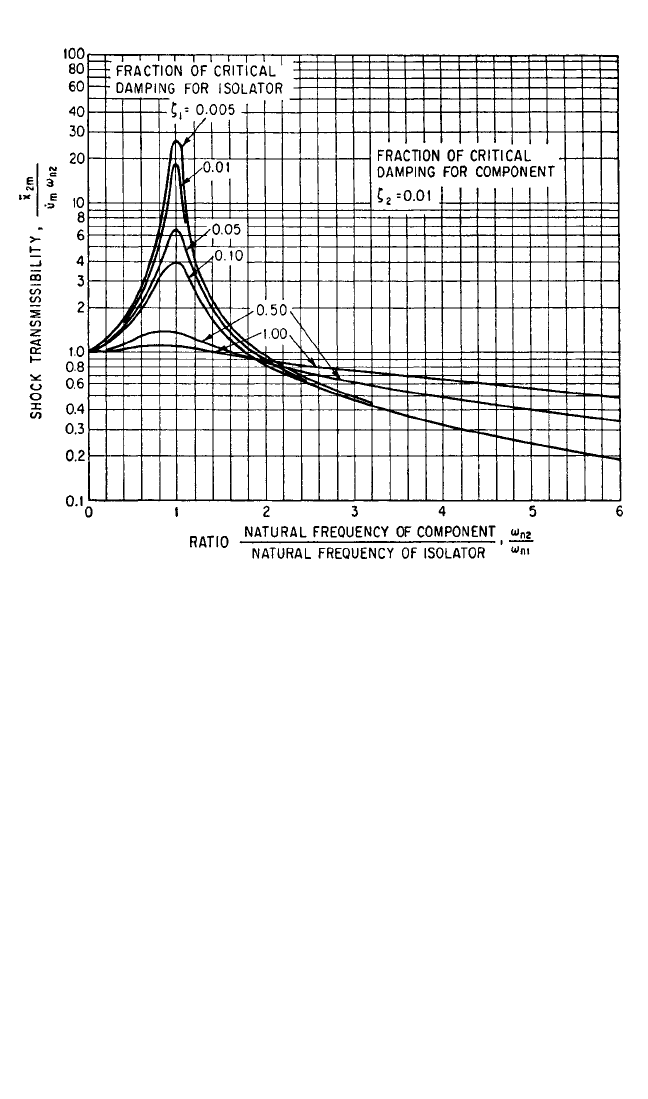
The ordinate in Fig. 31.28 represents the ratio of the maximum acceleration of
the component to that which would be experienced with the isolator rigid (absent);
thus, it may properly be called shock transmissibility. If shock transmissibility is less
than unity, the isolator is beneficial (for the component considered). An isolator
must have a natural frequency significantly less than that of the critical component
in order to reduce the transmitted acceleration. If there are several critical compo-
nents having different natural frequencies ω
n2
, each must be considered separately
and the natural frequency of the isolator must be significantly lower than the lowest
natural frequency of a component.
Two Degrees-of-Freedom—No Damping. This section includes an analysis of
the transient response of the two degree-of-freedom system shown in Fig. 31.4,
neglecting the effects of damping but assuming the equipment mass m
1
and the com-
ponent mass m
2
to be of the same order of magnitude. The equations of motion are
m
1
¨
δ
1
+ k
1
δ
1
= k
2
δ
2
− m
1
ü
m
2
¨
δ
2
+ k
2
δ
2
=−m
2
¨
δ
1
− m
2
ü
(31.39)
where k
1
= stiffness of isolator spring, lb/in., and k
2
= stiffness of component, lb/in.The
system is initially in equilibrium; at time t = 0, the left end of the isolator spring is
THEORY OF SHOCK ISOLATION 31.27
FIGURE 31.28 Shock transmissibility for a component of a viscously damped system with linear
elasticity, where the effect of the component on the equipment motion is neglected.
8434_Harris_31_b.qxd 09/20/2001 12:33 PM Page 31.27

given a velocity step of magnitude
˙
u
m
. Initial conditions are:
˙
δ
1
=
˙
u
m
,
˙
δ
2
= 0, δ
1
=δ
2
= 0.
Equations (31.39) may be solved simultaneously for maximum values of the acceler-
ation
¨
x
2m
of the component and maximum deflection δ
1m
of the isolator:
¨
x
2m
=
˙
u
m
ω
n2
− 1
2
+
2
1/2
(31.40)
1 +
1 +
δ
1m
=
+ 1
2
+
2
1/2
(31.41)
where
¨
x
2m
= maximum absolute acceleration of component mass, in./sec
2
; δ
1m
=
maximum deflection of isolator spring, in.; ω
n1
* = angular natural frequency of iso-
lator (k
1
/m
1
)
1/2
, rad/sec; and ω
n2
* = angular natural frequency of component
(k
2
/m
2
)
1/2
, rad/sec. (The natural frequencies ω
n1
and ω
n2
are hypothetical in the sense
that they do not consider the coupling between the subsystems.) Equation (31.40) is
shown graphically in Fig. 31.29. The dimensionless ordinate is the ratio of maxi-
mum acceleration
¨
x
2m
of the component to the maximum acceleration
˙
u
m
ω
n2
which
the component would experience with no isolator present.The abscissa is the ratio
of component natural frequency ω
n2
to isolator natural frequency ω
n1
. Separate
curves are given for mass ratios m
2
/m
1
= 0.01, 0.1, 0.3, and 1.0. Equation (31.41) is
shown graphically in Fig. 31.30. The ordinate is the ratio of the maximum isolator
deflection δ
1m
to the deflection
˙
u
m
(1 + m
2
/m
1
)
1/2
/ω
n1
which would occur if compo-
nent stiffness k
2
were infinite. The abscissa is the ratio of natural frequencies
ω
n2
/ω
n1
, and curves are given for values of m
2
/m
1
= 0.1 and 1.0.
Figure 31.29 shows that the effect of the mass ratio m
2
/m
1
upon the maximum
component acceleration
¨
x
2m
is very great near resonance (ω
n2
/ω
n1
1). As ω
n2
/ω
n1
increases above resonance, the effect of finite component mass steadily decreases.
Figure 31.30 shows that except for small values of ω
n2
/ω
n1
the effect of finite compo-
nent mass on the maximum isolator deflection δ
1m
is slight. As ω
n2
/ω
n1
increases, the
curves for all mass ratios asymptotically approach the ordinate 1.0.
The factor (1 + m
2
/m
1
)
1/2
in the ordinate parameter of Fig. 31.30 is introduced
because the total equipment mass is m
1
+ m
2
. For the limiting case of rigid equipment
(k
2
infinite), the natural frequency ω
n
is given by
ω
n
2
=ω
n
=
Substituting this relation in Eq. (31.18) and solving for δ
1m
:
δ
1m
=
˙
u
m
(1 + m
2
/m
1
)
1/2
/ω
n1
This is in agreement with the result given by Eq. (31.41) as ω
n2
/ω
n1
approaches infinity.
Example 31.4. Equipment weighing 152 lb has a flexible component weighing
3 lb. The angular natural frequency of the component is ω
n2
= 130 rad/sec.The equip-
ment is mounted on a shock isolator with a linear spring k
1
= 2400 lb/in. and having
a fraction of critical damping ζ
1
= 0.10. Find the maximum isolator deflection δ
1m
and
ω
n1
(1 + m
2
/m
1
)
1/2
k
1
m
1
+ m
2
ω
n2
ω
n1
m
2
m
1
ω
n2
ω
n1
˙
u
m
ω
n1
m
2
m
1
ω
n2
ω
n1
ω
n2
ω
n1
m
2
m
1
ω
n2
ω
n1
31.28 CHAPTER THIRTY-ONE
8434_Harris_31_b.qxd 09/20/2001 12:33 PM Page 31.28
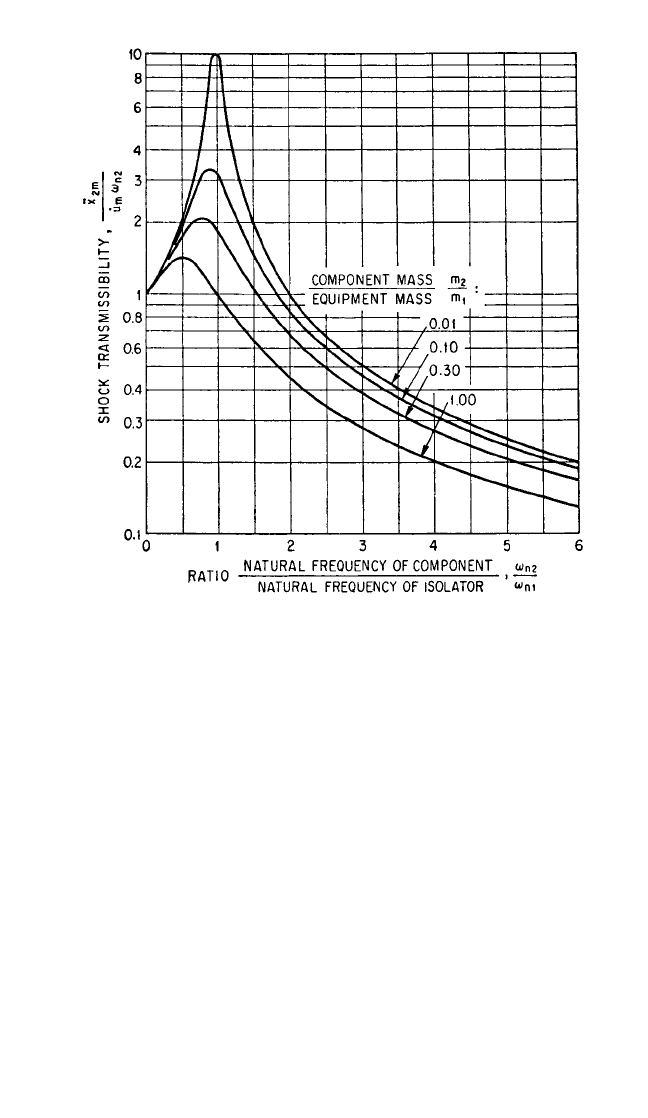
the maximum component acceleration
¨
x
2m
which result when the base experiences a
velocity step
˙
u
m
= 55 in./sec.
Consider first a solution assuming that m
2
has a negligible effect on the equip-
ment motion:
m
1
==0.393 lb-sec
2
/in.
ω
n1
=
=
= 78.1 rad/sec [12.4 Hz]
Figure 31.14 gives
¨
x
1m
/
˙
u
m
ω
n1
= 0.88 and Fig. 31.15 gives
¨
x
1m
δ
1m
/
˙
u
m
2
= 0.76 for ζ
1
= 0.1.
Then
δ
1m
=×= =0.61 in.
In finding
¨
x
2m
it is assumed that damping of the component has the typical value
ζ
2
= 0.01. Using ω
n1
/ω
n2
= 130/78.1 = 1.67, Fig. 31.28 gives
¨
x
2m
/
˙
u
m
ω
n2
= 1.15; then
¨
x
2m
= 1.15
× 55 × 130 = 8230 in./sec
2
= 21.3g.
0.76 × 55
0.88 × 78.1
˙
u
m
ω
n1
0.76
0.88
2400
0.393
k
1
m
1
152 lb
386 in./sec
2
THEORY OF SHOCK ISOLATION 31.29
FIGURE 31.29 Shock transmissibility for component of system of Fig. 31.4
under impact at velocity
˙
u
m
without rebound, where component and isolator
have undamped linear elasticity.
8434_Harris_31_b.qxd 09/20/2001 12:33 PM Page 31.29
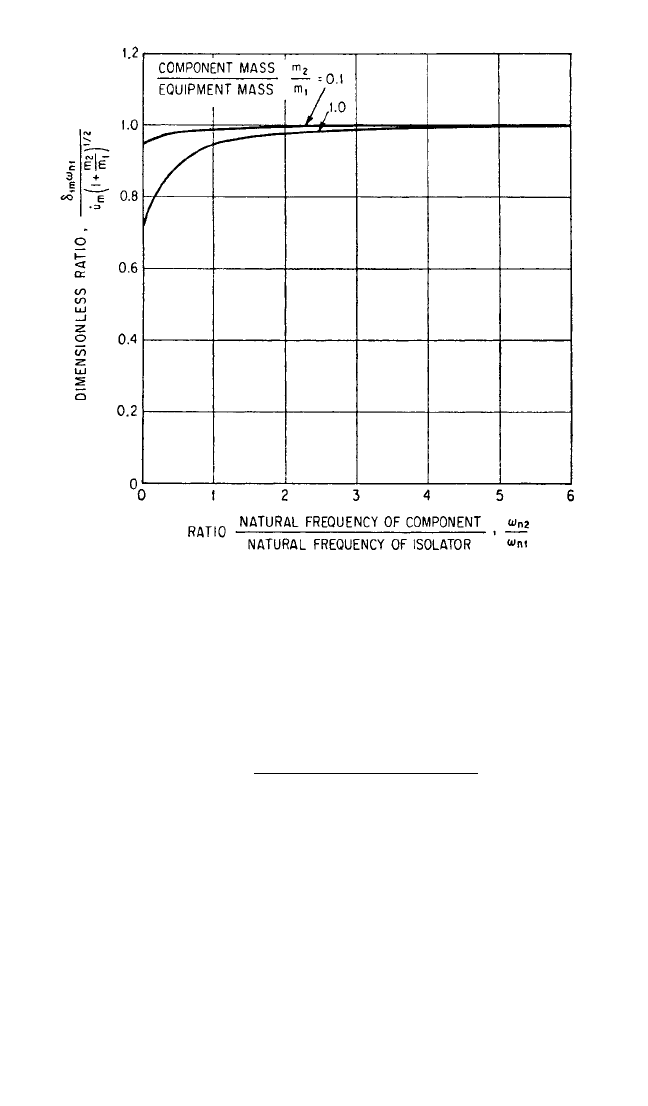
FIGURE 31.30 Dimensionless representation of maximum isolator deflection
in system of Fig. 31.4 under impact at velocity
˙
u
m
without rebound, where com-
ponent and isolator have undamped linear elasticity.
A second solution, taking into consideration the mass m
2
of the component, may
be obtained if the damping is neglected. From Eq. (31.41),
1 +
1 +
δ
1m
=
+ 1
2
+
2
1/2
=× =0.71 in.
From Eq. (31.40):
¨
x
2m
=
˙
u
m
ω
n2
− 1
2
+
2
−1/2
= 55 × 130[(0.67)
2
+
3
⁄152(1.67)
2
]
−1/2
= 10,070 in./sec
2
= 26.1g
ω
n2
ω
n1
m
2
m
1
ω
n2
ω
n1
1 + 1.67(1 +
3
⁄
152)
[(2.67)
2
+
3
⁄152(1.67)
2
]
1/2
55
78.1
ω
n2
ω
n1
m
2
m
1
ω
n2
ω
n1
˙
u
m
ω
n1
m
2
m
1
ω
n2
ω
n1
31.30 CHAPTER THIRTY-ONE
8434_Harris_31_b.qxd 09/20/2001 12:33 PM Page 31.30

This example is too complex for a practicable solution when damping and the mass
effects are considered together. However, the two above solutions may be taken
conservatively as limiting conditions; it is unlikely that the actual acceleration and
deflection would exceed the maxima of the limiting conditions.
SUPPORT PROTECTION
This section considers conditions in which the shock originates within the equipment
(e.g., guns and drop hammers).Attention is first given to determining the response of
the support for such equipment in the absence of a shock isolator. The effect of a
shock isolator introduced to protect the support from excessive loads is considered
later.
EQUIPMENT RIGIDLY ATTACHED TO SUPPORT
If the equipment is rigidly attached to the support, the support and equipment may
be idealized as a single degree-of-freedom system for purposes of a simplified analy-
sis. Consider the system of Fig. 31.3B with the spring-dashpot unit 2 assumed to be
rigid.The mass m represents the equipment, and the mass m
F
represents, with spring
and dashpot assembly (1), the support. The force F, applied externally to the equip-
ment, is taken to be a known function of time. The equation of motion is
(m
F
+ m)
¨
δ+F(
˙
δ,δ) = F
Considering only force-time relations F(t) in the form of a single pulse, the analo-
gous mathematical relations of Eqs. (31.5) and (31.6) are used by defining the
impulse J applied by the force F as
J =
τ
0
F dt (31.42)
where τ is the duration of the pulse.
Short-Duration Impulses. If τ is short compared with the half-period of free
oscillation of the system, then the results derived in the section on Response of a
Rigid Body System to a Velocity Step may be applied directly. An impulse J of negli-
gible duration acting on the mass m produces a velocity change ˙u
m
given by
˙
u
m
= (31.43)
The subsequent relative motion of the system is identical with that resulting from a
velocity step of magnitude
˙
u
m
.
If the damping capacity of the support is small, then velocity step results derived
for linear springs, hardening springs, and softening springs are applicable. If the
damping of the support may be represented as viscous and the stiffness as linear,
then the linear-spring viscous damping results apply. In most installations it is suffi-
ciently accurate to consider the support an undamped linear system.
A structure used to support an equipment generally has distributed mass and
elasticity; thus the application of an impulse tends to excite the structure to vibrate
J
m
THEORY OF SHOCK ISOLATION 31.31
8434_Harris_31_b.qxd 09/20/2001 12:33 PM Page 31.31

not only in its fundamental mode but also in higher modes of vibration. The mass-
spring-dashpot system shown in Fig. 31.3B to represent the structure would have
equivalent mass and stiffness suitable to simulate only the fundamental mode of
vibration. In many applications, such simulation is adequate because the displace-
ments and strains are greater in the fundamental mode than in higher modes. The
vibration of members having distributed mass is discussed in Chap. 7, and the for-
mulation of models suitable for use in the analysis of systems subjected to shock is
discussed in Chap. 28, Part II.
Long-Duration Impulses. If the duration τ of the applied impulse exceeds about
one-third of the natural period of the equipment-support system, application of
velocity step results may be unduly conservative. Then the results developed in the
section on Response of Rigid Body System to Acceleration Pulse are applicable. The
mathematical equivalence of Eqs. (31.5) and (31.6) is based on identifying −mü in
the former with F in the latter. Accordingly, if the shape of the force F vs. time curve
is similar to the shape of the curve of acceleration ü vs. time, then the response of a
system to an acceleration pulse may be used by analogy to find the response to a
force pulse by making the following substitutions:
ü
m
=τ
r
=
where F
m
is the maximum value of F, ü
m
is the maximum value of ü, and τ
r
is the
effective duration. If the mathematical equivalence is literally applied, F
m
/m is anal-
ogous to −ü
m
, not ü
m
. Since acceleration pulse results are given in terms of extreme
absolute values, the sign is not important.
EQUIPMENT SHOCK ISOLATED
Idealized System. When a shock isolator is used to reduce the magnitude of the
force transmitted to the support, the idealized system is as shown in Fig. 31.4. Sub-
system 2 represents the equipment (mass m
2
) mounted on the shock isolator (right-
hand spring-dashpot unit). Subsystem 1 is an idealized representation of the support
with effective mass m
1
and with stiffness and damping capacity represented by the
left spring-dashpot unit. The free end of the latter unit is taken to be fixed (u = 0).
It is assumed that the system is initially in equilibrium (
˙
δ
1
=
˙
δ
2
= 0; δ
1
=δ
2
= 0) and
that force F (positive in the +X direction) applies an impulse J to m
2
.Analysis is sim-
plified by treating the duration τ of impulse J as negligible. This assumption, always
conservative, usually is warranted if the natural frequency of the shock isolator is
small relative to the natural frequency of the support.
System Separable. In many applications the support motion x
1
(=δ
1
) is suffi-
ciently small compared with the equipment motion x
2
that the equipment accelera-
tion
¨
x
2
is closely approximated by
¨
δ
2
where
¨
x
2
=
¨
δ
2
+
¨
x
1
. Using this approximation, the
analysis is resolved into two separate parts, each dealing with a single degree-of-
freedom system.
If the system consists only of linear elements as defined by Eq. (31.7), the equa-
tion of motion of the equipment mounted on the shock isolator (subsystem 2 of Fig.
31.4) is
J
F
m
F
m
m
31.32 CHAPTER THIRTY-ONE
8434_Harris_31_b.qxd 09/20/2001 12:33 PM Page 31.32
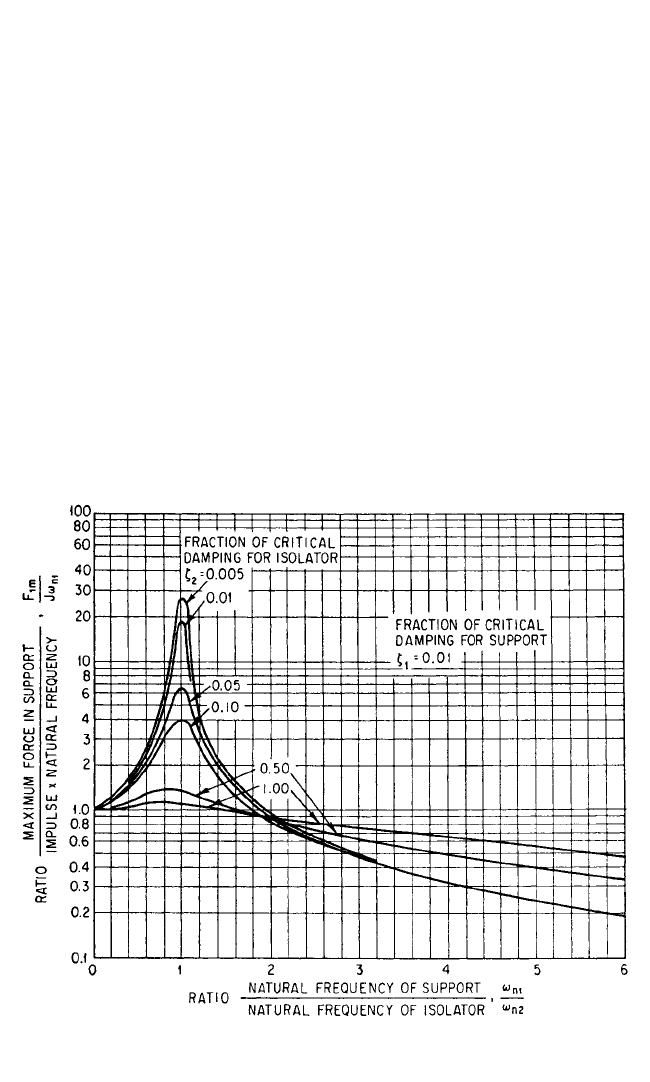
¨
δ
2
+ 2ζ
2
ω
n2
˙
δ
2
+ω
n2
2
δ
2
= 0 (31.44)
where ω
n2
2
= k
2
/m
2
and ζ
2
= c
2
/2m
2
ω
n2
. The initial conditions are: δ
2
= 0,
˙
δ
2
=
˙
u
m
= J/m
2
when t = 0. Because of the similarity of Eqs. (31.26) and (31.44), and the respective
initial conditions, the maximum equipment acceleration
¨
x
2m
and the maximum isola-
tor deflection δ
2m
may be found from Figs. 31.14 and 31.15. The differential equation
for the motion of the support in Fig. 31.4 is
¨
δ
1
+ 2ζ
1
ω
n1
˙
δ
1
+ω
n1
2
δ
1
=−
¨
x
2
(31.45)
where ω
n1
2
= k
1
/m
1
and ζ
1
= c
1
/2m
1
ω
n1
. The initial conditions are
˙
δ
1
= 0, δ
1
= 0.
The solution of Eq. (31.45) is formally identical with that of Eq. (31.38) because
the equations differ only by the interchange of the numerical subscripts and the
presence of the factor m
2
/m
1
on the right-hand side of Eq. (31.45). The solutions of
Eq. (31.45) as obtained by a computer are shown in Fig. 31.31. The ordinate is the
ratio of the maximum force F
1m
in the support to the quantity Jω
n1
. The latter quan-
tity is the maximum force which would be developed in an undamped, linear, single
degree-of-freedom support of mass m
1
and stiffness k
1
if the impulse J were applied
directly to m
1
.The abscissa in Fig. 31.31 is the ratio of the undamped support natural
frequency ω
n1
to the undamped isolator natural frequency ω
n2
. Curves are drawn for
m
2
m
1
THEORY OF SHOCK ISOLATION 31.33
FIGURE 31.31 Dimensionless representation of maximum force in support F
1m
resulting from
action of impulse J on equipment.
8434_Harris_31_b.qxd 09/20/2001 12:33 PM Page 31.33

various values of the fraction of critical damping ζ
2
for the isolator, assuming that the
fraction of critical damping ζ
1
for the support is constant at ζ
1
= 0.01.
Figure 31.31 appears to show that the presence of an isolator increases the maxi-
mum force F
1m
transmitted by the support if the natural frequencies of isolator and
support are nearly equal.This conclusion is misleading because the analysis assumes
that the support deflection δ
1
is small compared with the isolator deflection δ
2
,a
condition which is not met in the neighborhood of unity frequency ratio. A more
realistic analysis involves the two degree-of-freedom system discussed in the next
section.
Two Degree-of-Freedom Analysis. This section includes an analysis of the sys-
tem of Fig. 31.4 considered as a coupled two degree-of-freedom system where both
the support and isolator are linear and undamped [F
1
(
˙
δ
1
,δ
1
) = k
1
δ
1
, F
2
(
˙
δ
2
,δ
2
) = k
2
δ
2
].
This analysis makes it possible to consider the effect of deflection of the support on
the motion of the equipment. Fixing the support base (u = 0), the equations of
motion may be written
¨
δ
1
+ω
n1
2
δ
1
=ω
n2
2
δ
2
¨
δ
2
+ω
n2
2
δ
2
=−
¨
δ
1
(31.46)
Assuming that the impulse J has negligible duration, the initial conditions are:
˙
δ
1
= 0,
˙
δ
2
= J/m
2
, δ
1
=δ
2
= 0. The solution of Eqs. (31.46) parallels that of Eqs. (31.39); the
resulting expressions for the maximum isolator deflection δ
2m
and force F
1m
applied
to the support are
δ
2m
=
1 +
−1/2
(31.47)
F
1m
= Jω
n1
1 −
2
+
−1/2
(31.48)
The maximum deflection of the isolator given in Eq. (31.47) is shown graphically
in Fig. 31.32. For small values of the ratio of support natural frequency to isolator
natural frequency, the flexibility of the support may significantly reduce the maxi-
mum isolator deflection, especially if the mass of the support is small relative to the
mass of the equipment. For large values of the frequency ratio, the effect of the mass
ratio is small.
Maximum values of force in the support, given by Eq. (31.48), are shown in Fig.
31.33.The maximum deflection of the floor is the maximum force F
1m
divided by the
stiffness of the floor.The effect of mass ratio is profound for small values of the fre-
quency ratio.The curves of Figs. 31.31 and 31.33 show corresponding results, the for-
mer including damping and the latter including the coupling effect between the two
systems.The analysis which ignores the coupling effect may grossly overestimate the
maximum force applied to the support at low values of the frequency ratio. At high
values of the frequency ratio, the two analyses yield like results if the fraction of crit-
ical damping in the isolator is less than about ζ
2
= 0.10. The two methods are com-
pared in Example 31.5.
Example 31.5. A forging machine weighs 7000 lb exclusive of the 600-lb ham-
mer. It is mounted at the center of a span formed by two 12-in., 50 lb/ft I beams hav-
m
2
m
1
ω
n1
ω
n2
m
2
/m
1
(1 +ω
n1
/ω
n2
)
2
J
m
2
ω
n2
m
2
m
1
31.34 CHAPTER THIRTY-ONE
8434_Harris_31_b.qxd 09/20/2001 12:33 PM Page 31.34
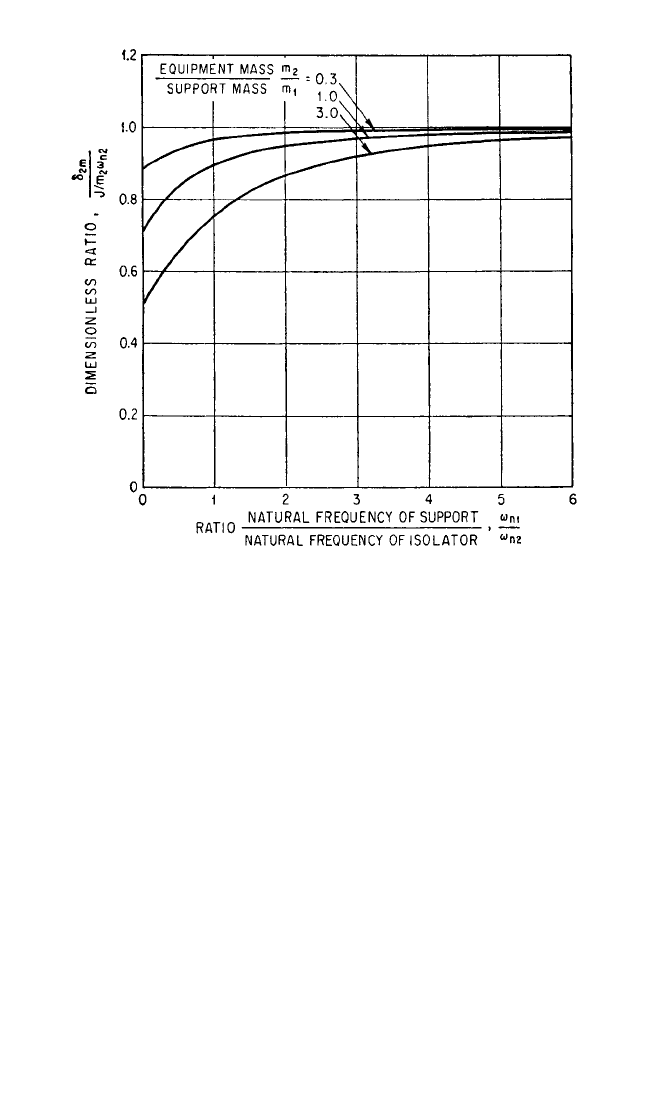
ing hinged ends and a span l = 18 ft. The hammer falls freely from a height of 60 in.
before striking the work. Determine:
a. Maximum force F
1m
in the beams and maximum deflection δ
1m
of the beams if the
machine is rigidly bolted to the beams.
b. The maximum force F
1m
in the beams and the maximum deflection δ
2m
of an iso-
lator interposed between machine and beams.
Solution
a. When the machine is bolted rigidly to the beams, the system may be consid-
ered to have only a single degree-of-freedom. The mass is that of the machine, plus
the hammer, plus the effective mass of the beams. For the machine: m
2
= (7000 +
600)/386 = 19.2 lb-sec
2
/in. The effective mass of the beams is taken as one-half of the
actual mass:
m
1
==2.33 lb-sec
2
/in.
m = m
1
+ m
2
= 21.5 lb-sec
2
/in.
The stiffness of the beams is
2(0.5)(18)(50)
386
THEORY OF SHOCK ISOLATION 31.35
FIGURE 31.32 Dimensionless representation of maximum isolator deflec-
tion δ
2m
resulting from action of impulse J on equipment. Isolator and support
have undamped linear elasticity.
8434_Harris_31_b.qxd 09/20/2001 12:34 PM Page 31.35
